- Home
- About us
- Products
- Dealer Enquiry
- Blog
- Contact Us
- Home
- About us
- Products
- Dealer Enquiry
- Contact Us
- 044 -2486 1994
- +91 99623 98222
- sales@nantech.in
- REQUEST A QUOTE
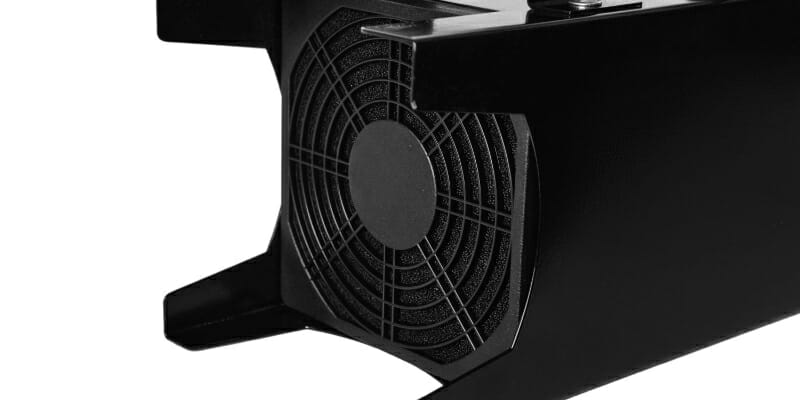
Facing a power quality issue? Get yourself an Active Harmonic Filter and reduce harmonic pollution during electrical installation. Using an active harmonic filter ensures that the current is "clean". An active harmonic filter requires a stable external power source to inject phase opposite current harmonics to downstream loads. Depending on the stability of the connected external power source, its efficiency will vary.
In this blog, we analyze the pros and cons of harmonics. But first, let's see what leads to harmonics in the power system.
Technically speaking, when the current waveform deviates from the sinewave shape, it is said to contain "harmonics." Is that a good or bad sign? Apparently, harmonics is a bad sign because harmonic frequencies in the power grid cause power quality issues. Why do harmonics occur? Leading inverter battery manufacturers and suppliers from Nantech Power Systems Pvt Ltd, Chennai, point out two things:
Blame 1: Non-linear loads
Power distribution circuits use non-linear devices that create non-linear currents and cause voltage distortions. Some common examples are:
"Harmonic current" is a term commonly used to describe these non-linear currents and voltages. A high load on the power distribution network leads to harmonic currents, which are multiples of the fundamental frequencies.
Blame 2: Electronic switching devices
The excessive use of electronic switching devices in modern equipment has significantly increased the harmonic pollution in the electrical distribution system. Some of the common examples are:
To rectify these power issues, we need one main aspect: Harmonic filters to harmonics coming from the power distribution network. These filters use "frequency conversion technology" to control harmonics and improve power quality in two ways:
With the availability of passive filters, why do experts lean towards active harmonic filters to rectify harmonics in power generation? The reasons are obvious. These filters come equipped with an additional amplifier that changes their action and improves stability. An active filter also:
However, these above-mentioned factors are just the tip of the iceberg. In our next section, we have explained more remarkable advantages in great detail.
Also Read: Why Choose Active Harmonic Filters Over Passive Harmonic Filters?
1. Prevent equipment failure and breakdowns.
When many small harmonic-producing devices are collectively causing large amounts of harmonic pollution, filtering the main power supply is a very useful solution. Active harmonic filters effectively prevent failures and breakdowns of devices since they help correct non-linear loads. The filters also provide energy efficiency, which helps extend the durability of the device.
2. Help in maximum use of installed capacity.
An ideal example of active harmonic filters maximizing installation capacity is their use in the AC lines parallel to the loads that produce offending harmonics. The active harmonic filters inject inverted current into the AC lines and cancel harmonics, improving electrical stability.
3. Improve energy efficiency.
One of the best aspects of active harmonic filters is that they are scalable and sized to the harmonic current for multiple loads. You can also install additional units if the total harmonic current exceeds the rating of the single harmonic filter. They also decrease the emission of carbon dioxide.
4. Reliable and provide continuity.
Active Harmonic Filters are handy for areas with significant non-linear loads and many DC drives because they reduce production disruptions. Therefore, these filters also extend the device's life, enabling them to perform consistently well.
5. Curb service and maintenance costs.
Any electrical device that operates at maximum efficiency is bound to work without issues. This theory is applicable for devices with active harmonic filters. Unless the capacitors and resistors are required, the active harmonic filter does not require custom fabrication because it is largely impedance-independent. According to the manufacturers, active harmonic filters can handle wideband harmonic frequencies to minimize service costs.
6. Prevent and reduce energy loss.
Harmonic pollution is synonymous with energy loss because it affects electrical installations' reliability, safety, and efficiency. An active harmonic filter installed on the main power supply can counteract all harmonic currents before reaching the transformer. They also reduce the absorption of reactive power and reduce wear and tear, thereby preventing energy loss.
7. Reduce fire risks.
Harmonic frequencies can increase heating in equipment and conductors. However, with active harmonic filters, you can:
Active harmonic filters are a sure-fire way to reduce fire risks due to overheating.
If you decide to use active harmonic filters, you should also know their shortcomings. Experts say these filters:
The Takeaway
The demand for active harmonic filters is at an all-time high, thanks to the widespread proliferation of non-linear loads. They have become almost indispensable for large power installations, with electric arc furnaces, induction equipment, and electric furnaces. Yes, the active harmonic filter is here to stay!
Want to know more about the active harmonic filter? Visit our webpage right now, or give us a call to know how you can use it to your advantage.

The wind, water, and sun are the three big players of Green Energy. Of the three, solar energy has grabbed global attention as an effective solution to reduce energy consumption and environmental damage.
The global shift is driven by government initiatives and a massive adoption of solar lighting systems like solar street lights. Why solar street lights? The answer is obvious. The entire world is focussing on sustainable power sources to curtail greenhouse emissions. The relentless pursuit of green power drives the need and the market growth for solar street lights. Here's the proof: Global experts say that the market for solar street lighting will reach $14billion by 2027, with a post-Covid CAGR of 14.7%.
In India, solar street lights are a common sight. Thousands of them dot the highways that criss-cross the length and breadth of the country. As dawn turns to dusk, these solar street lights come alive and flood the highways with clean, sustainable power.
Standalone solar street lights are fast gaining power for some good reasons. They are:
Rather than relying upon on-grid power supply, solar street lights rely on batteries or photovoltaic cells for solar energy storage. This aspect makes solar street lights a feasible option to power highways and roads in remote places without any power grid source. These systems can also use the stored energy by converting it into electricity as per the requirement. For your solar street lights to function well, they must be exposed to direct sunlight, allowing them to soak up the solar energy for at least eight hours. Once charged, they are good to go for the rest of the night.
If you are looking to invest in solar street lights, it is undoubtedly a wise decision because these solar-powered solutions are fast gaining traction. The popularity of these street lights is driving the market and vice versa. The solar lighting market is flooded with dozens of options that could be overwhelming for inexperienced investors. If you are not well-informed, you may buy low-quality solar street lamps manufactured with sub-par materials.
However, our blog is packed with all the information you need to consider when investing in solar street lights. Let's read on.
When make enquiries about solar street light dealers in Chennai for solar-powered lamp sources, they come up with several options like:
Of these choices, the best option that's a close replica of the sun's spectrum is the LED light. Nowadays, smart solar-powered LED lights are powered by higher lumens that use less energy. Furthermore, LED lights make solar power integration simple and easy. So, they could be the better choice.
All solar lights are powered by batteries, which are available in two types:
Of the two, lithium batteries are better because they have:
It is important to note that the battery capacity should meet the lighting efficiency requirement. If not, the street lamp will not provide adequate lighting during the rainy season.
When you are at a latitude greater than 15 degrees, the sun's inclination angle with the ground is greater than 15 degrees. Therefore, you must consider solar street lights with adjustable solar panels. Also, the panels of solar street lights installed on both sides of the road should not face away from the sun.
The heat dissipation is another important factor determining the LED lamp's quality. Basically, heat dissipation is nothing more than the transfer of heat. However, dissipation also refers to heat loss driven by undesirable effects. Therefore, every time the heat dissipation is inadequate, the lifespan of the semiconductor device in the street lamp is shortened. It is better to choose anti-ultraviolet and fireproof LED lights to ensure adequate heat dissipation.
When considering solar street lights, look for details about the footcandles as they determine the illumination on the floor. Ideally, the bright/dark ratio should be 4:1, but a minimum ratio of 3:1 is also good. You should also consider the colour temperature, measured in degrees Kelvin.
It is better to opt for light coloured lamps since black coloured lamps are highly heat absorbing. If the lamp is black, the temperature of the metal shell can reach up to 90 degrees Celsius underexposure. The high temperature will destroy the battery and the LED light source. Therefore, choose a silver shell that will not absorb heat or fade when placed outdoors.
Charging and discharging controllers are also known as solar controllers, and they coordinate the work of solar panels, storage batteries, and loads. An effective heat dissipation function is crucial for selecting a controller. Another essential feature is temperature compensation. A smart controller has been added to prevent overcharging and undercharging of solar batteries. You would be better off investing in a smart solar controller with built-in communication that allows real-time monitoring and control of the system. The controller would offer maximum performance and longevity.
The sensors are of two types:
The PIR or the Passive Infrared Sensor is included in many solar street lights to help conserve energy. The sensors work by measuring infrared light allowing the sensor to detect movement.
The solar controller coordinates the work of the panels, loads, and batteries. Hence it is essential to pick a controller which gives you the following benefits:
The solar panel is the main component of the solar street lighting system. To determine the quality of the solar panels, you should:
Solar street lamps are certainly a big investment. Hence you need to ensure the manufacturer offers an extended warranty period of 20 to 25 years. Also, look for reputable solar street light dealers that offer good after-sales services.
In this model, the solar panels are attached to the poles. This panel positioning is slightly disadvantageous because the sunlight effect is minimal, and the absorption effect is only one-fifth of the ordinary solar lights. Moreover, the absorption rate is almost nil when the sun is directly above.
The conversion equipment is different in this model because the conversion mechanisms are different. If wind energy is used to charge the battery, it will cause decay and affect the battery life. Hence, this model may not be the right choice if you are looking for solar lights that will last a long time.
Nantech Power Systems Pvt Ltd are one of the most recognized solar street light dealers in Chennai. We have years of experience dealing with off-grid and on-grid solar power plants and street light installations. Want to power up your locality? Call us today.

The recent Union Budget 2022 rolled out the blueprint for India's 100th year. And the main focus was economic development. To do that, one of the notable suggestions was to give emphasis on creating infrastructure for the mass adoption of electric vehicles. Our Finance Minister, Nirmala Sitharaman, announced the Battery Swapping Policy. This policy is aimed at making EV's more accessible to the public by making them more affordable.
Any discussion about EV is never complete without discussing EV charging solutions. These vehicles will need charging plug points in all public places so that they can be charged easily and quickly. These charging stations are usually designed to dispatch DC or AC power (Direct Current, Alternating Current). The DC charging infrastructure is approximately 5X times quicker than the AC charging infrastructure. And, that makes the cost difference 100X times.
This disparity clearly indicates that DC charging stations will scale much slower than the AC charging stations. And that further turns our attention to the fact that India needs a more reliable alternate method to charge their electric vehicles.
Now, battery swapping makes a grand entry here. The concept of battery swapping is simple- any user can quickly replace a discharged battery with a new, fully-charged battery within a matter of minutes. It will be far easier than a trip to the nearest petrol bunk. IoT (Internet of Things) will check the battery's charge and offer the right guidance as to which battery to select at the swapping station. Thus you can ensure that the battery is completely charged and not just partially charged. Now that you know what battery swapping is, let us now take a look at the battery swapping policy announced by our Finance Minister!
During the Budget speech of Nirmala Sitharaman, she mentioned that "considering the constraint space in urban areas for setting up (electric vehicles) charging stations, a battery swapping policy will be brought out and interoperability standards will be formulated."
So, what are the key points we can derive from it?
India lacks the presence of easy to access EV charging stations in public places. We do not have the infrastructure to support it. This makes EV's an unattractive option for people who are looking for convenient solutions. In such a situation, battery swapping stations are a great alternative. It requires less space and can be easily incorporated into our existing infrastructure. EV owners can quickly swap the drained batteries of their EV and swap them with fully charged batteries.
The Battery Swapping Policy has also made it clear about establishing standards of interoperability. This will further make battery swapping easier for EV owners as any EV battery can be used in any EV brand. It simply means that the battery used in brand A can also be used in brand B and vice versa.
As a direct after-effect of the policy, there will be an increased investment by both new and existing EV manufacturers. Manufacturers will now focus more on improving the efficiency level of batteries and introducing embedded technologies. The set standards will be equally beneficial for EV owners as well. They will now get to choose between various competitive EV brands.
If you analyse the costs involved in an electric vehicle, the battery cost is a major contributor. The cost of materials involved in developing the battery and technologies administered to make it efficient makes the overall cost of EV go higher and higher. Now, with the introduction of battery swapping, we can remove the battery part from EV as a separate purchase. This will make the cost of EV drop significantly. Though you will still have to buy a battery for your EV, the reduced upfront cost will make EV's more affordable for one and all. Interested to know more about EV? The experts at Nantech, Chennai, is here to assist you. Get in touch with us today!
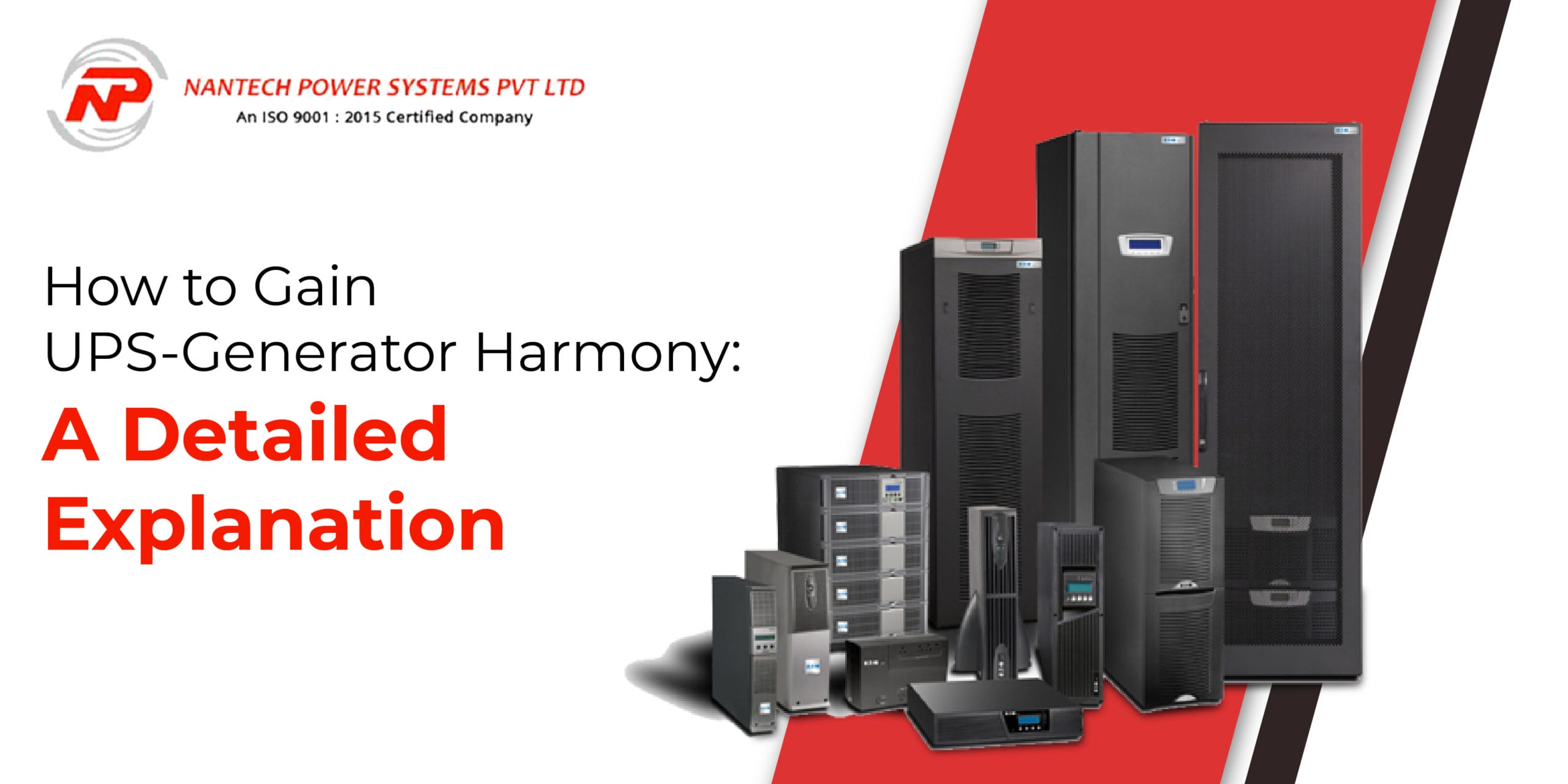
With unreliable grid power supply being the norm of the day, most businesses and industries have equipped themselves with generators or UPS. Some of them are clever enough to invest in both to ensure a reliable chain of power 24/7.
The world stands divided over which power solution is better- the Uninterrupted Power Supply (UPS) or the generator. As one of the leading UPS manufacturers, we at Nantech, Chennai, suggest combining the best of both worlds. UPS and generators are both essential parts of any power infrastructure. When integrated, they provide you with a seamless, highly-effective, and safe power solution for your business.
In this blog, we've explained everything you need to do to gain the combined power of your UPS and generator. But here's a small intro about both power sources before we venture into the details.
Popularly called the UPS, the Uninterruptible Power Supply is an electrical apparatus that provides backup power when the main power supply is compromised. From powering a small household to running your entire computer system, the UPS is the top choice for many people.
The device contains batteries that automatically detect any loss of power and kick in to fill the gap within seconds or minutes. This results in assured continuity and functionality of your electric devices. Additionally, the UPS also safeguards your devices from unexpected power surges.
The backup generator can come in sizes as small as a suitcase or as large as a house. This self-powered device can generate electricity by converting mechanical power into electrical power. As per their capacity, generators can provide power for a longer period and effortlessly run heavy appliances.
Despite their differences in design and function, UPSs and generators are the most reliable solutions for uninterrupted power supply. Technology has simplified the way businesses operate and ease our reliance on electricity. Hence, it is easy to understand the outcome if these devices are used as a combination rather than stand-alone solutions.
If you plan to invest in both the UPS and generator, you need to know what to do to optimise these solutions and gain the most from them. Here are our guidelines.
The concept behind the UPS-generator combo is to use the UPS running as long as possible and then switch to the generator power. The generator will supply the power until the main supply is restored or until the system is properly shut down. Generators and UPS can work in perfect harmony as long as you implement these best practices.
Always assess your generator frequency when using the UPS-generator combo. Here's why:
If the UPS' input voltage and frequency exceed the set level, the UPS will slip into the battery mode. When connected to the generator, the UPS may consider a generator an unstable power source if its frequency range is too wide. As a result, the UPS will run permanently on the battery, resulting in the battery failing and dropping your load.
List the electrical devices you want your generator to power. This list includes the AC, lighting, computer systems, and other vital services. Now, assess if your generator can power these devices. If your generator isn't large enough, it will not be able to hold voltage and frequency within input tolerances.
Therefore, if you aim for potential growth with a generator-friendly UPS, it is wise to size up your generator whenever your budget allows it.
There are three fuel options to get your generator up and running:
Assess their pros and cons and choose the option that works best. For example, natural gas may slow down your generator and not deliver the desired outcome. Besides, you may have to invest in a larger generator in due course of time. On the other hand, propane is a better choice. However, it is diesel that takes the cake. It is the most preferred solution for generators with 50kW or more. On the downside, diesel costs are skyrocketing, and the fuel also has a short storage life.
Generally, there is an increase in temperature by 10 degrees Celsius when the generator operates. If the ambient temperature is around 40 degrees Celsius, the additional heat will damage your generator. You need to provision and scale your generator for more power to prevent this. You can:
People often overlook the need for strong electrical grounding, which could be a serious mistake when the UPS and generators are concerned. Electrical currents normally use the UPS to dissipate to the ground. Without proper grounding, they will bypass the UPS and use your cables and other devices to get to the ground. This sudden surge of electricity can cause equipment damage, shock hazards, and data loss.
To prevent this, you should:
There's a good reason why we offer this suggestion:
In standby and line-interactive UPSs, battery power prevents frequency variations from affecting the protected load. In contrast, a double-conversion, online UPS recreates the sine wave and filters frequency variations during normal operation. Therefore your battery life remains as good as gold.
Moreover, the online UPS corrects voltage and frequency deviations since it constantly rectifies AC to DC and then inverts it back to AC. Therefore, if you are looking for seamless generator integration, double-conversion UPS is the right choice.
Here are some more pointers to keep in mind to optimise your UPS-generator integration:
You can always rely on our experts at Nantech to provide technical advice and consultation with UPS-generator integration. Please feel free to reach out to us for the right guidance.
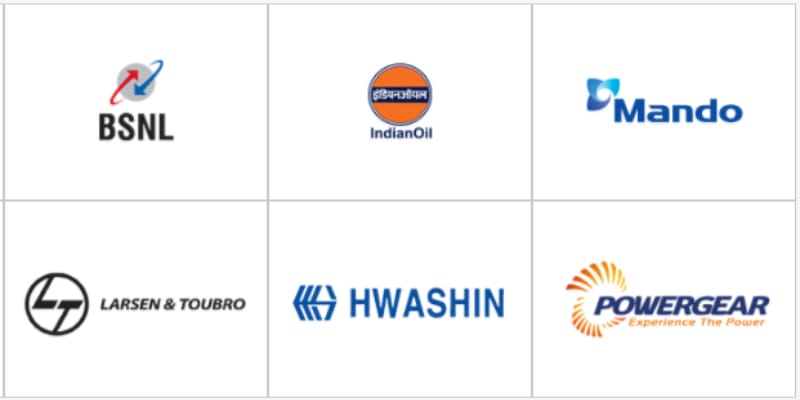
The sun is our biggest source of energy. It is clean, uncompromised, unadulterated, sustainable, and renewable. With at least 300 cloudless, sunny days in a year, India is a prime location for capitalising on solar energy. Moreover, the location and demographic of India makes it conducive for deploying solar energy systems. Therefore, signing a contract with your solar panel manufacturer could be a brilliant way to save money and electricity.
Solar panel installation could mean a world of difference for your business overheads. But do they work for everyone? Apparently so. Statistics say India added 8,811 Mega Watts of solar power capacity within January to September 2021. This number is about 280% higher than the previous year's numbers.
According to the Ministry of New and Renewable Energy (MNRE), solar energy contributes 46% share in the total Renewable Energy segment. This makes solar energy the major contributor of renewable energy, followed by wind energy and bio-power.
If these statistics are not enough to convince you about investing in solar panels, we have the reasons to help you understand why it is a worthwhile investment.
Solar panel installation is a long-term investment, and it may take a while before you start generating a decent ROI. Therefore, you should consider a few factors before giving the green signal. You need to:
Coming back to our topic of discussion, here are some of the top reasons to capitalise on solar power installation:
1. Tax benefits galore
The biggest advantage of investing in solar energy is the tax benefits offered by the state and central governments. The government offers tax incentives and financial programs to show their support and consider the high upfront costs of solar panel installation. The top five support systems offered by the Indian government to promote solar energy are:
2. Reduced operational expenses
Solar energy opens the gateway to operating a business almost free of electricity charges. Therefore, no matter how large and profitable your organisation is, a solution with the potential to eliminate such a large expense should be ignored.
A well-designed solar panel system can curb your power bill upto 75%. For example, let's assume you pay Rs.10,000 a month for electricity consumption. Once you've installed solar panels, this number could drop to Rs.2500 per month. You can use the saved money to expand your business or automate your workflow. You could even invest it in a monitoring software that tracks your solar system's energy generation.
The possibilities are endless! So, why miss it?
3. Increased property value
Will your solar panels increase your property taxes? Not likely. Will it increase your property value? Not many people will say no to clean, renewable energy that comes loaded with tax benefits.
Houses and commercial buildings with rooftop solar panel installations have a higher market value than those without them. Moreover, total ownership of the installation allows you to transfer it to the new owner without any hassles.
4. Longevity and sustainability
Solar power is the largest untapped renewable power source with indefinite longevity and sustainability. Every other power source has its limitations.
Hydroelectric power, for example, is clean power but is highly dependent on monsoonal rains. Besides, the need for additional hydroelectric power adds to the risk of flooding premium lands and the destruction of ecosystems. On the other hand, nuclear power is also highly susceptible to accidents and nuclear waste problems. Fossil fuels like coal and petroleum are already facing a bleak future.
Solar power is the clear winner here, harvested as long as the sun blazes on.
5. Low maintenance costs
Commercial solar panels require little maintenance and are virtually silent. The solar cells are encased in a non-corrosive aluminium frame surrounded by tempered, protective glass. As a result, they are built specifically to stand up to the elements, enduring rain, hail, wind, and snow - just about any weather-related threat. Moreover, they are usually located on the roof of commercial buildings, so they are easily accessible for maintenance activities.
6. Low carbon footprint
If you want to be an environmentally responsible business, switching to solar energy would be the best option. Even a small rooftop solar panel can significantly reduce carbon dioxide emissions. Studies suggest that an average 3kW solar system has the potential to power an entire household. Therefore, the carbon emissions produced from one household equals the amount that can be avoided by installing just one solar panel.
Also Read: Solar Panels: An Eco-Friendly Way To Power Your Home
7. Elimination of power outages
Unexpected power outages are like a plague for the Indian industrial sector. A single power outage can cause serious problems such as:
However, the situation is entirely different with solar energy. The chances of facing power outages are almost nil as there is consistent energy input to keep your operations running to full capacity.
8. Generates great ROI
When switching to solar power, you are making an investment rather than an expense. This is an investment that generates better ROI than many of your other investments. Many businesses are wary about taking the plunge with solar power installation because of the initial expenses. However, it doesn't take long to harvest your initial investment once your ROI starts rolling in.
9. Complete energy independence
When you welcome solar energy, you assert your independence from being dependant on commercial energy sources. Being completely energy independent also means that you:
10. Support for the local economy
When you opt for solar panel installation, you are simultaneously providing job opportunities for job installation experts in your locality. You are, thereby, boosting the local economy by increasing the job availability for experienced and deserving candidates. Don't forget that these very workers could end up being your future customers!
Solar power technology is a wise investment that requires the guidance of experts before you give your consent. Nantech Power Systems Pvt Ltd has a team of experts well-versed in the business nuances of this investment. Call us to discuss your strategies and power requirements to make your decision worthwhile in the long run.
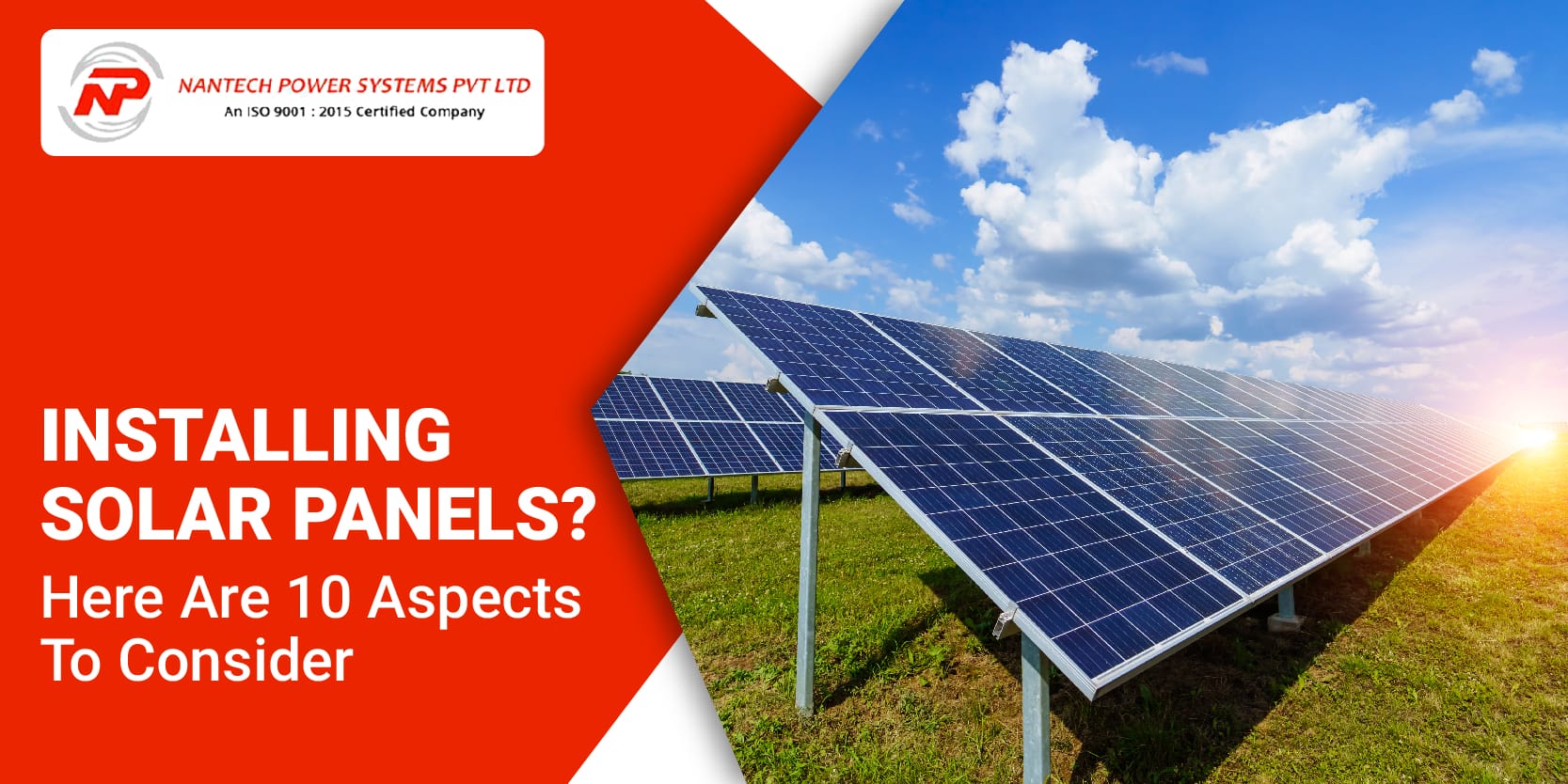
Harnessing the energy of the blazing sun is perhaps the most effective, sustainable, and cost-effective solution to power homes and establishments in India. In Chennai, where the sun beats down mercilessly for much of the year, it could prove a worthwhile investment. Besides, who would say no to a lifetime of sustainable energy?
Over the years, there has been an increased awareness of the importance of renewable energy. Also, as solar energy is seen as the best alternative energy source, people see it as a sensible investment.
It won't take long before you think about buying solar panels to power your home or business. However, like every other purchase, this is an investment that requires careful planning and consideration. To help you make a wise choice, we compiled a list of factors to consider before you bring home your solar panels. Let's take a look.
Condition and layout of your roof
Since your solar panels will be housed on the roof of your building, it is the first thing to come under the scanner. Before you go ahead with the purchase, your roof should be inspected by a professional to assess three aspects:
Depending on the number of panels you require, it can add considerable weight to your roof. Therefore, ensure your roof is in perfect condition and do the required renovations before giving the green signal for the installation.
Property's exposure to sunlight
When evaluating your property before the installation, check if it receives at least four to five hours of direct sunlight. You also need to rule out any sources of shading like trees or buildings that may block the sun from your panels. That said, you should remember that your solar panels will receive photons from the sun even on cloudy days. They do not require blue skies throughout the year, so do not fret!
Amount of energy required.
Your household's energy consumption is determined by the number of family members, electrical devices, usage, and so on. To ascertain the exact number of panels required, you can do the following calculation:
Kilowatts of energy used per day x 0.25 = Number of panels required to produce energy.
Government incentives for solar energy
Solar energy is free and clean energy, and the government provides incentives and subsidies to those wishing to install solar panels. The main objective here is to allow electricity generated from photovoltaics to compete with other energy sources. Apart from India, many other countries provide solar power subsidies to encourage this investment. Therefore, it is crucial to collect all the available information and gain maximum benefits with these incentives.
Choosing the right company for the installation
Solar panel installation is a job for professionals well-versed in similar electrical projects. It is not a DIY project. You will need a reputed installer who will:
It is important to note that certified professionals can only carry out solar panel installation.
Will you lease or buy?
Depending on your finances, you have two options to invest in solar panels:
Whatever the choice, it is a win-win situation as the benefits and profits override the disadvantages.
Connected to the grid or off-grid
Another big decision for installation depends on whether you want to be connected to the grid or run an off-grid system that stores the electricity. Let's break it down for you:
Grid system: Provides you with Net Metering, an incentive that gives you credit on your bill for the excess power produced by your solar panels.
Off-grid system: Not connected to your electricity bill. Hence you need a large storage capacity to save energy and use it when required.
Positioning of your panels
The position of your solar panels has a great impact on the amount of energy generated. For example, if you live in the northern hemisphere, the sun is south of the sky. Hence, if the panels are placed on a south-facing roof, it will allow maximum exposure to the sun's rays. Here are more guidelines for solar panel positioning:
We suggest you seek professional guidance from installation experts to get things done the right way.
Also Read: Understanding The UPS( Uninterruptible Power Supply)
The main objective of installing solar panels is to generate your source of energy and curb electricity expenses. However, it can be tough to calculate how much money you will save. You can use this formula to estimate your saved expenses with solar energy:
Your electricity rate (INR/kWh) + your GST x your solar power system size x 1,168
Go Solar To Save The Earth!
Whether you are saving small or big, you are playing your part in using natural, sustainable energy. Yes, solar panels are a significant investment, but it is one of the best choices you can make.
To ensure that your panels are performance-tested, you should reach out to expert installers like Nantech Power Systems Pvt Ltd. We are Chennai's leading solar panel supplier, experts in installing on-grid, off-grid, and solar-powered street lights. Let's discuss your solar panel requirements and get going with your installation process!
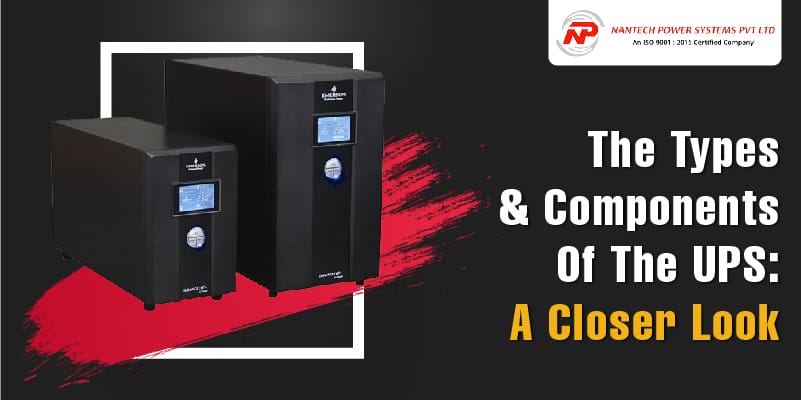
In this age and time, all of us have either used or seen the UPS. It is that magic box that keeps your computer working, the fan running, and the TV blaring even during power cuts. Short for "Uninterruptible Power Supply", UPS is now a common household name. By simple definition, the UPS is an equipment that provides a continuous power supply to electronic devices.
The unreliability of the main electric supply is what fuels the need for the UPS system. In a city like Chennai, you can list a dozen reasons for power failure. The reasons are endless, from shut-downs, load shedding, voltage spikes, and sag, to harmonic distortion and maintenance issues.
In short, the UPS is the savior that powers and protects all hardware components that you rely on for your business and personal work. This includes computers, telecommunication equipment, data centers, and even your fans, lights, and kitchen appliances.
Therefore, it is only fair that you learn more about the UPS, its types, and its key components. This knowledge will help you understand how this device works and to identify and avoid potential problems. So let's get started.
Based on its different working principles, the UPS device is categorized into three types.
1. Standby UPS
The basic Standby UPS is a source of short-term, battery-sourced power during outages. Commonly used for computers, VoIP equipment, and modems, this UPS powers the hardware through a direct AC connection. In this UPS model, the inverter and standby unit are essentially idle until backup power is required. Data and sensitive equipment can also be secured with a standby UPS device, depending on its model. The Standby UPS also comes in compact versions for home networks.
2. Online UPS
The Online UPS is an energy-efficient power supply system powered by either a double or delta conversion technology. When it works with the double conversion technology, the UPS does not directly receive electricity from the AC outlet. Instead, the power first travels to a rectifier, where it is converted into DC power. After this conversion, the DC power travels to the battery and then an inverter, where it is again converted back to AC power. This reconverted, clean AC power is delivered to the equipment.
When it works with delta conversion, the online UPS sends a certain amount of power directly to the equipment that needs to function.
3. Line-Interactive UPS
This type of UPS is similar to the Standby UPS, requiring at least ten minutes of transfer time to power up a device. The line-interactive UPS is also a bit expensive. That's because the load is passed on to the AC unit via a bypass mode applied to the power supply. This solution serves as a backup if the UPS function fails. This UPS can also be used with less than 6kVA power ratings. It is also very ideal for household and office applications.
Now that we've dealt with the types let's explore the main components of the UPS device.
Also Read: Quick Tips To Keep Your Car Battery Healthy
On the outside, the UPS is but a plain box with a red light and a few electrical outlets embedded on its back. It is noiseless, and except for that occasional beeping noise, it is hardly noticeable. But there's a lot that goes on with the UPS system, which comprises four main components we have explained in detail.
1. The Rectifier or Charger
The rectifier has one main function: to ensure the batteries are fully charged while waiting to be activated during a power failure. It converts the AC power from the mains into DC power to charge the UPS battery.
In smaller UPS systems, the rectifier and the charger work as two separate modules. In larger systems, they work as a combined component. Also, the charger setup is different for offline and online UPS as the power flow is different for both models.
2. The UPS Battery
As the component that stores the power supply used during a power shortage, the battery serves as the heart of the UPS system. The batteries are stored in long connected strings to ensure continuous power. Therefore, if one battery fails, the entire string is likely to fail. This is why the battery ought to be frequently tested.
The available battery power determines the runtime of your UPS. This power is measured in amp-hours. Hence, the more batteries your UPS has, the more runtime it provides. This is why many people choose to invest in External Battery Packs or EBMs to increase the UPS runtime when there's an emergency.
3. Static Bypass Switch
Your UPS system is designed to be reliable at all times- including those moments when the UPS itself is faulty. During such instances, the static bypass switch automatically connects the load to the main supply and powers your device. It is called the "bypass" switch because it bypasses the rectifier, inverter, and batteries.
The power provided by the static bypass switch is not clean, as it does not undergo the entire conversion and re-conversion process. Nevertheless, it will power your device until the UPS issue is solved.
4. Inverter
To power your systems and devices with AC power, the inverter plays an instrumental role by switching the DC power from the rectifier back to AC power. This conversion of AC to DC and vice versa is crucial as it ensures the resultant power is a pure sinewave. The inverter smoothes any disruptions, dips and surges in the AC power to keep your devices safe.
In an online UPS, the inverter is constantly active and alive as it ensures a seamless change when there's a power disruption. However, in offline UPS, the inverter is activated through a bypass switch. The inverter ensures the AC power is modulated, uninterrupted and consistent.
The UPS comes in many sizes, from small compact ones to really bulky models. Other than the above-mentioned components, there are other parts that you must also be aware of. They include:
You must choose a UPS system for your business that is both cost- and requirement-effective. At Nantech Power Systems Pvt Ltd, we can help you pick the right UPS system that suits your needs. As one of the most reputed UPS dealers in Chennai, we are well-known for our products and services. Do get in touch with us to discuss your UPS requirements with our team.
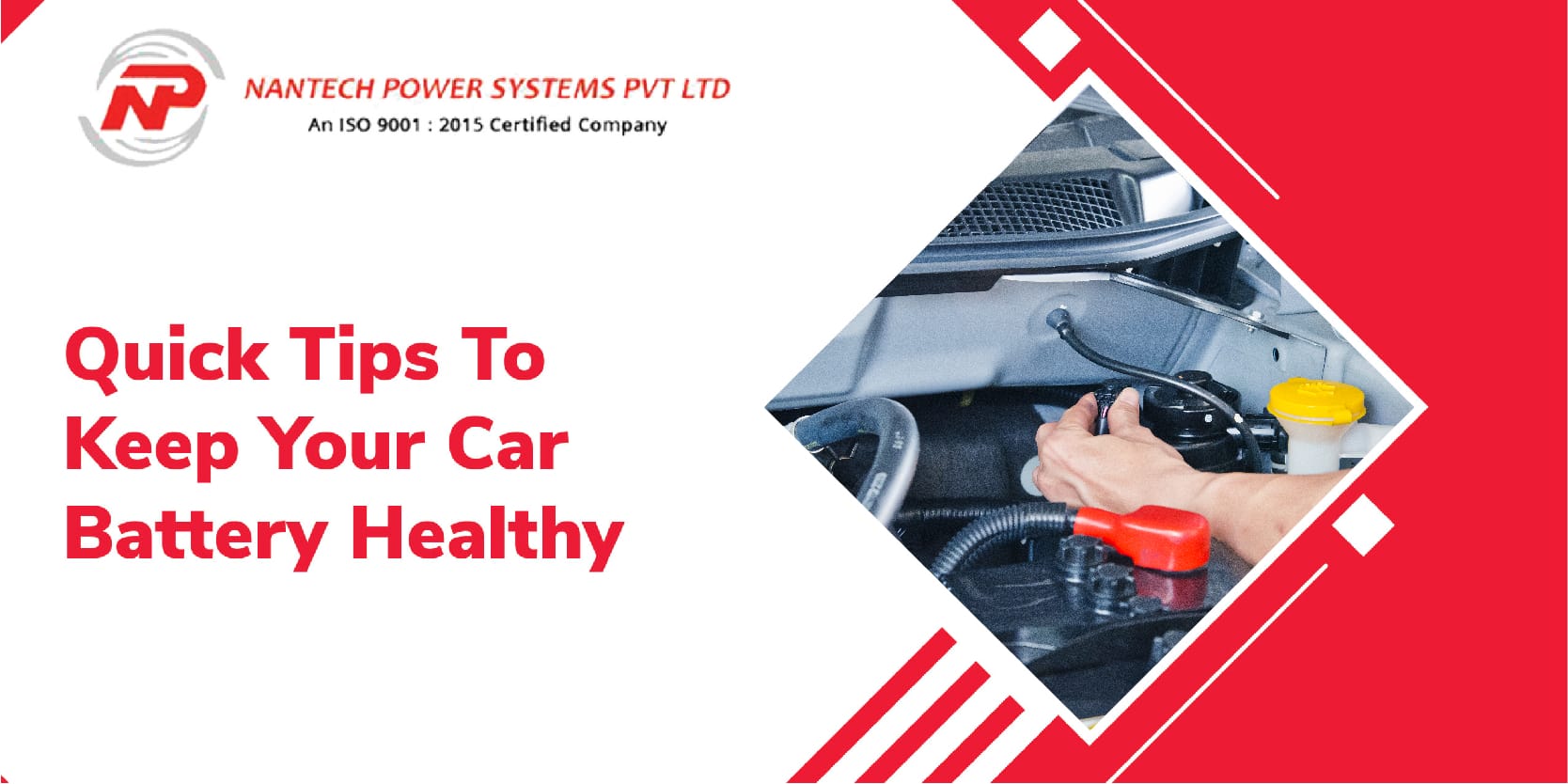
A battery is an indispensable part of your car. It can be compared to what the heart does to the human body- It constantly streams in a steady power source into your car components. All of the car’s electronics, including the ECU, headlights, AC, music system, horns, and even the starter motor, rely on the battery to function. And, that is why just like how we should keep our heart healthy, we should also keep our car battery healthy.
Say Checkmate To Climate
On average, a car battery should last between 2 and 6 years. However, the temperature can have a huge impact on the average battery life. A hot day can negatively affect the battery’s life expectancy because of the evaporation of its fluids. So, to make your battery last as long as possible, you must consider the climate in which you will drive. You should take extra care if you are driving in a hot climate.
It’s true that the climate is uncontrollable. But, you can control the battery damage in more than one way. Our experts understand your concerns about maintaining your vehicle batteries. That’s why we’re here to give you 8 tips to take good care of your car battery. As Chennai’s leading Exide car battery dealers and having served our clients for over two decades, we are confident that our maintenance guide will help your batteries last longer.
A car’s battery is unquestionably one of its most essential components. While car operations are almost impossible with low batteries, its high repair and replacement costs make maintenance even more essential. Regular maintenance will ensure the safety of car batteries for many years to come.
In light of our experiences, we have listed below some tips for maintaining your car battery.
Let shade be your car’s brigade
It has been observed that high temperatures often impact the volume of Sulphuric acid inside the battery. Rapid evaporation of the acid causes the battery to die sooner. The best way to protect your car battery from high heat and humidity is to park it in a shaded area or under a covered parking area. This will ensure that your vehicle is not directly exposed to heat.
Clean the batteries umpteen times
Over time, car batteries accumulate dust and corrosion. Rust can form over metal parts of the battery, especially around the terminals, if exposed to dirt and humidity for a long time. These are often the major causes of short circuits and discharges that hinder the longevity of your battery. Therefore, it is highly recommended to clean the battery regularly with a dry cloth to ensure a steady flow of power for a long time.
Say no to quick rides
Short rides prevent your car’s battery from getting fully charged. To avoid this, we recommend driving long distances and doing so more frequently. Investing in a portable car battery charger is a sensible option if you don’t drive your car too often. You can use portable chargers to jump-start your car if you get stranded on the road. You will not have to rely on getting assistance from other vehicles if you have a portable charger with you.
Also Read: Why Should You Rent A UPS System?
Monitor the battery’s water level regularly
Battery cells contain distilled water which must be monitored regularly to ensure the appropriate level is maintained. Over time these liquids tend to evaporate and get drained, eventually concentrating the acid. This condition can result in corrosion and reduced battery life. To ensure that the battery’s water level is maintained properly, and if it becomes low, top it up right away.
Fasten your battery tight
Loosely fitted batteries are prone to vibration. Vibration can cause serious internal damage and short circuits. Regularly inspect the terminals of your car battery to make sure it is fastened tightly to the mounting bracket. This is especially important when you make a long and bumpy ride in your car.
Lower the power usage
You should turn off your air conditioner and radio when the engine is not running. Using these power-consuming features can cause wear and tear on your battery. It has also been observed that extended periods of idling are harmful to the batteries.
Ride often
Unused cars can reduce the lifespan of their batteries if they are left for long periods. If you do not use the batteries for a long time, you will be unable to start the vehicle. If you are not in town, ask a friend to drive your car around.
Never forget to turn off the lights
When you step out of your car, make sure you turn off your car’s lights. Leaving the headlights or door lights on can shorten the life of your battery. Consider making it a habit to check the car’s lights every time you use it. This way, you ensure that your battery is not stressed or overloaded, thereby extending its life.
Maintaining a car’s battery is vital to avoid incidents of breakdowns and unexpected damages. With the eight tips mentioned in this article, be confident about driving your car safely and without the fear of breaking down. As one of the best USP and Exide car battery dealers in Chennai, we ensure that your car batteries receive prolonged service life and optimum performance. Our services and products are exclusively designed to exceed your expectations and keep you satisfied in all possible ways.
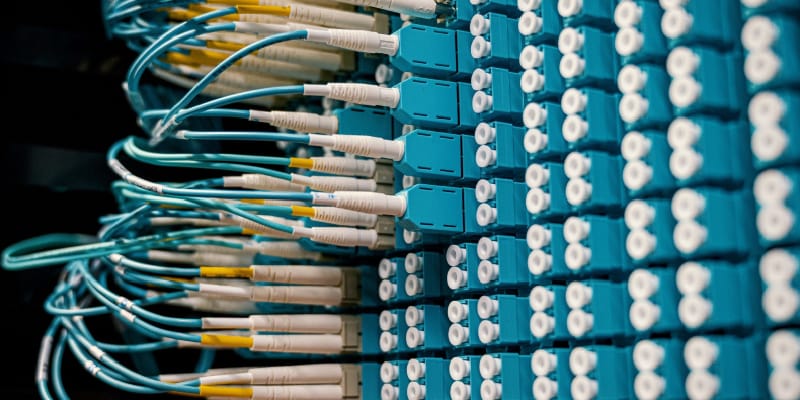
Nantech uses modern state of the art equipment, they then conduct Power Quality Audits and Power monitoring at various Engineering, Automobile, Aerospace, Pharmaceutical, IT Data centers, Textile, Printing, Defence & Railway establishments at a national level. The important factors while writing an audit of an instrument are its Voltage range, Frequency range, Transient response(response of system to change from steady state), Lag, current requirement ,Harmonics(voltage or current at multiple of frequency produced by non-linear loads) etc.
Nantech’s online UPS is a 3 phase four wire system. Its input voltage can range from 300V to 480 V and the output of this voltage will be between 380V to 400V with a ±1% range of variation. Its input frequency is 50 Hz with a ±10% variation and at the same time for the output frequency the variation regulation becomes ±0.05Hz. The voltage harmonics are less than 3% of its initial linear load and the transient response is less than 8 ( which means 10-90% of the linear load)
Nantechs line interactive UPS is a single phase system. Its input voltage range varies from 160V to 280V and output voltage is 220V or 230V with ±1% variation. Its input frequency is 50 Hz with a ±10% variation and at the same time for the output frequency the variation regulation becomes ±0.05Hz. Input lag factor is less than 0.8. Transient response is less than 8 ( which means 10-90% of the linear load) and voltage harmonics is less than 3% of the linear load.
The Servo Stabilizer has an input voltage from 170V to 270V and output voltage is Voltage range- 230V ±1%. Its input frequency range is 47-53 Hz.
READ THIS ALSO: Healthy Maintenance of Your Transformer
Active Harmonic Filter has an input voltage range of 400V,3Ph +N(+10% or -15%) and frequency range of 50Hz(60 Hz optional) with ±10% variation.
Constant Voltage Transformer has input voltage between170 to 270 V ( can be customizable) and the output voltage is 220V-1%. Its input line frequency is – 50 Hz with - 0.5% variation. Output regulation is 2% at no load to full load.
In Ultra Isolation Transformer 55 to 680 vac voltage is available with Input voltage 115v or 230v or 415v and the Output regulation is less than 2%.
Input DC (current) ranges from 10.5 to 14.2 A. Its input voltage is 12V and output voltage can be 220V to 230V.
Note- Here the ± 10% symbolises that a variation of -10% to +10% is noticed while operating that system.
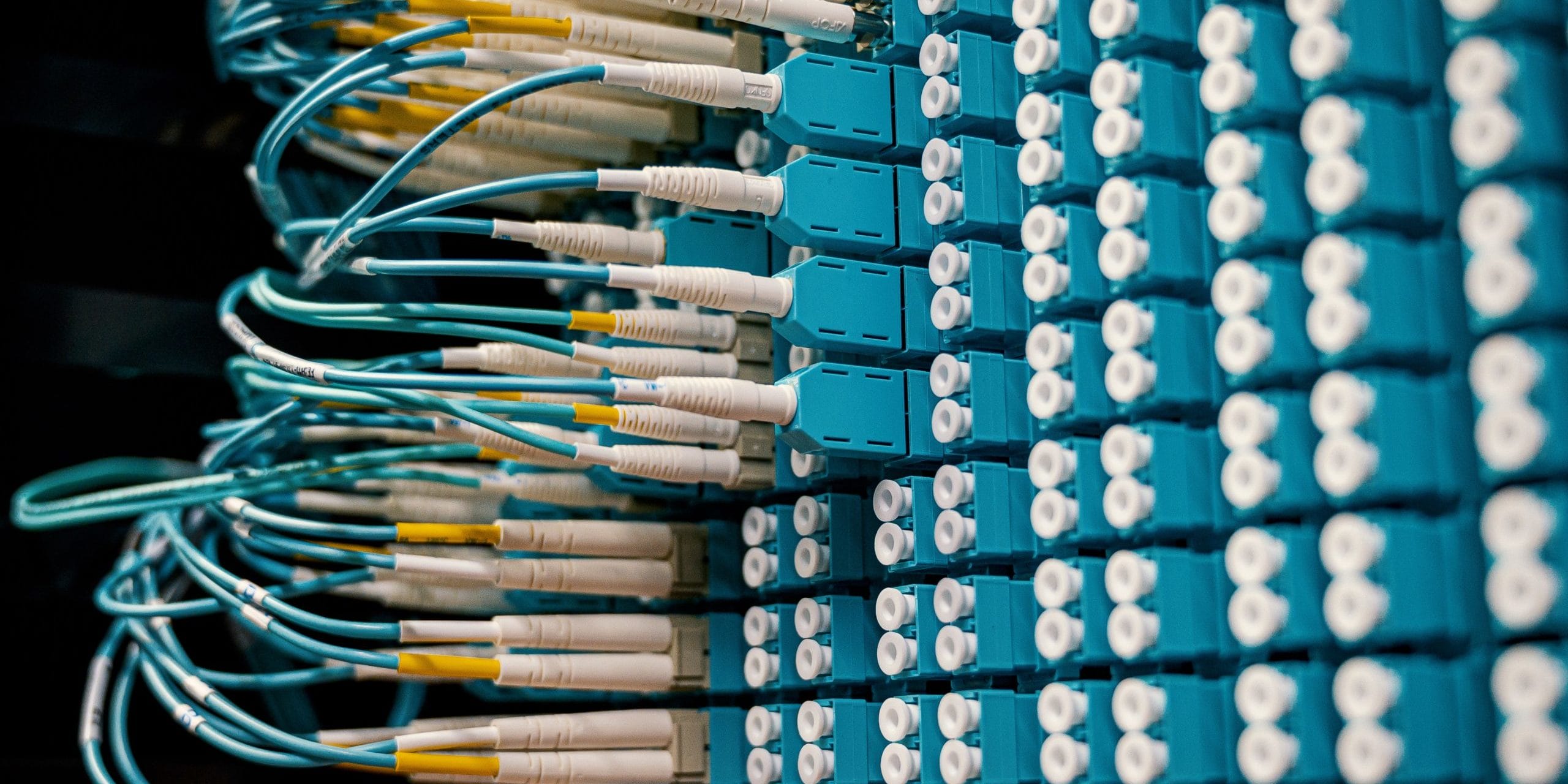
Transformers are a costly and necessary portion of any machinery. As it is used to minimize power line issues such as electrical noise, spikes, surges, and ground loops, insulation transformers are used. It also offers high resistance to insulation and complete electromagnetic and electrostatic shielding. So, it is best to conduct annual maintenance check ups on your machinery to get maximum efficiency and increase product life.
Nantech Power Systems Pvt. Ltd. which gives the best hardware solution in Chennai city also delivers AMCs (Annual Maintenance Contract) when selling our electrical goods.
ALSO READ THIS: What is an Annual Maintenance Contract? And Why Should You Worry About It?
Preventive maintenance can help to detect problems and provides:
Conclusion: A famous saying “a stitch in time saves nine” used to express that it is better to spend little time and effort right now to avoid major problems in the future which may lead to cost more money sometimes life too.